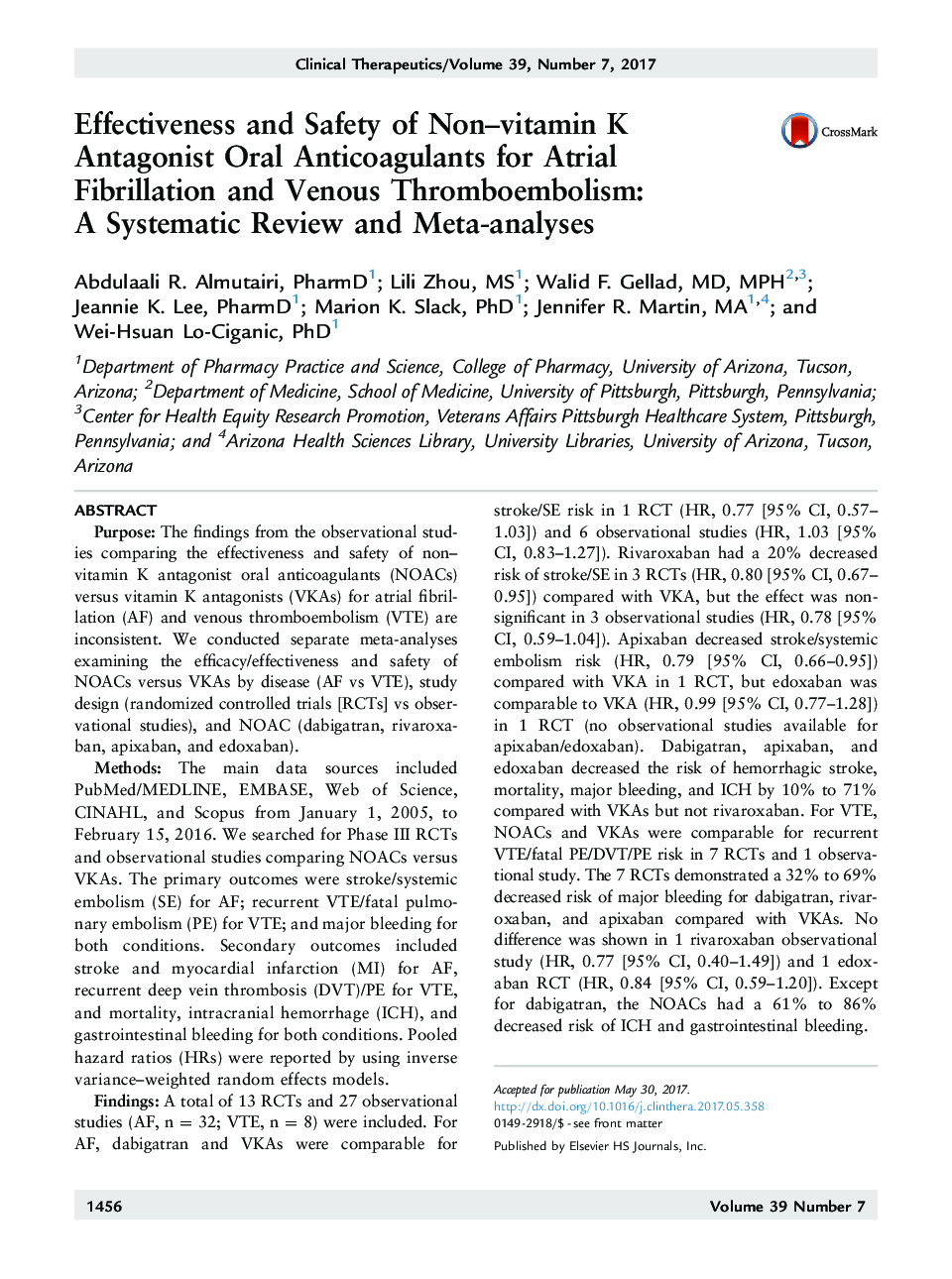| کد مقاله | کد نشریه | سال انتشار | مقاله انگلیسی | نسخه تمام متن |
|---|---|---|---|---|
| 5553727 | 1403012 | 2017 | 59 صفحه PDF | دانلود رایگان |

PurposeThe findings from the observational studies comparing the effectiveness and safety of non-vitamin K antagonist oral anticoagulants (NOACs) versus vitamin K antagonists (VKAs) for atrial fibrillation (AF) and venous thromboembolism (VTE) are inconsistent. We conducted separate meta-analyses examining the efficacy/effectiveness and safety of NOACs versus VKAs by disease (AF vs VTE), study design (randomized controlled trials [RCTs] vs observational studies), and NOAC (dabigatran, rivaroxaban, apixaban, and edoxaban).MethodsThe main data sources included PubMed/MEDLINE, EMBASE, Web of Science, CINAHL, and Scopus from January 1, 2005, to February 15, 2016. We searched for Phase III RCTs and observational studies comparing NOACs versus VKAs. The primary outcomes were stroke/systemic embolism (SE) for AF; recurrent VTE/fatal pulmonary embolism (PE) for VTE; and major bleeding for both conditions. Secondary outcomes included stroke and myocardial infarction (MI) for AF, recurrent deep vein thrombosis (DVT)/PE for VTE, and mortality, intracranial hemorrhage (ICH), and gastrointestinal bleeding for both conditions. Pooled hazard ratios (HRs) were reported by using inverse variance-weighted random effects models.FindingsA total of 13 RCTs and 27 observational studies (AF, n = 32; VTE, n = 8) were included. For AF, dabigatran and VKAs were comparable for stroke/SE risk in 1 RCT (HR, 0.77 [95% CI, 0.57-1.03]) and 6 observational studies (HR, 1.03 [95% CI, 0.83-1.27]). Rivaroxaban had a 20% decreased risk of stroke/SE in 3 RCTs (HR, 0.80 [95% CI, 0.67-0.95]) compared with VKA, but the effect was nonsignificant in 3 observational studies (HR, 0.78 [95% CI, 0.59-1.04]). Apixaban decreased stroke/systemic embolism risk (HR, 0.79 [95% CI, 0.66-0.95]) compared with VKA in 1 RCT, but edoxaban was comparable to VKA (HR, 0.99 [95% CI, 0.77-1.28]) in 1 RCT (no observational studies available for apixaban/edoxaban). Dabigatran, apixaban, and edoxaban decreased the risk of hemorrhagic stroke, mortality, major bleeding, and ICH by 10% to 71% compared with VKAs but not rivaroxaban. For VTE, NOACs and VKAs were comparable for recurrent VTE/fatal PE/DVT/PE risk in 7 RCTs and 1 observational study. The 7 RCTs demonstrated a 32% to 69% decreased risk of major bleeding for dabigatran, rivaroxaban, and apixaban compared with VKAs. No difference was shown in 1 rivaroxaban observational study (HR, 0.77 [95% CI, 0.40-1.49]) and 1 edoxaban RCT (HR, 0.84 [95% CI, 0.59-1.20]). Except for dabigatran, the NOACs had a 61% to 86% decreased risk of ICH and gastrointestinal bleeding.ImplicationsOverall, NOACs were comparable or superior to VKAs. Although no observational studies are currently available for apixaban/edoxaban, a few notable inconsistencies exist for dabigatran (ischemic stroke, MI) and rivaroxaban (stroke/SE, major bleeding in VTE) between RCTs and observational studies. Individualizing NOAC/VKA therapy based on benefit/safety profiles and patient characteristics is suggested.
Journal: Clinical Therapeutics - Volume 39, Issue 7, July 2017, Pages 1456-1478.e36